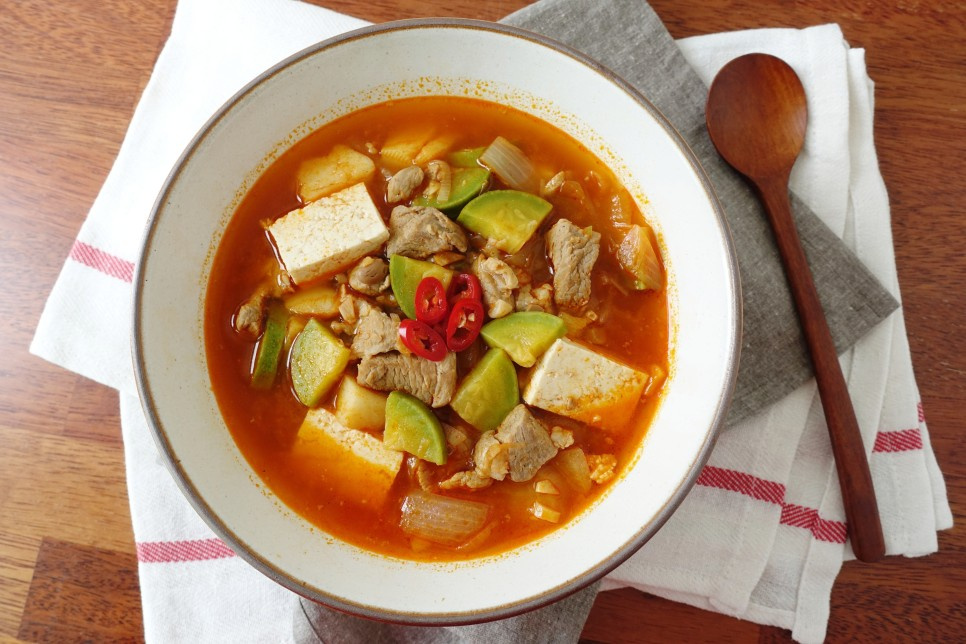Spicy and Sweet Pork and Zucchini Gochujang Stew
Rice-Thief! A Recipe for Spicy and Sweet Gochujang Stew with Thick Slices of Zucchini and Plenty of Pork

This is a recipe for Gochujang stew, a ‘rice thief’ dish, packed with sweet zucchini and generous amounts of pork. With thick-cut zucchini, soft tofu, refreshing radish, and potatoes, this hearty stew is so satisfying that you won’t need any other side dishes. Mixed with warm rice, it’s absolutely delicious! Enjoy this flavorful and slightly spicy stew, loved by the whole family, featuring the natural sweetness of zucchini.
Stew Ingredients- 1/2 zucchini
- 1/3 onion
- 1 handful of radish (thinly sliced)
- 1 small potato
- 1/3 block of tofu
- 250g pork (recommend pork neck or belly)
- 500ml anchovy-kombu broth (or rice water)
- A little green onion
Pork Marinade- 0.5 Tbsp minced garlic
- 0.2 Tbsp minced ginger (optional)
- A pinch of black pepper
- 1 Tbsp cooking wine (like mirin)
- 1 Tbsp soy sauce for soup
Seasoning Paste- 1 Tbsp soybean paste (doenjang)
- 2 Tbsp red chili paste (gochujang)
- 0.5 Tbsp minced garlic
- 0.5 Tbsp minced garlic
- 0.2 Tbsp minced ginger (optional)
- A pinch of black pepper
- 1 Tbsp cooking wine (like mirin)
- 1 Tbsp soy sauce for soup
Seasoning Paste- 1 Tbsp soybean paste (doenjang)
- 2 Tbsp red chili paste (gochujang)
- 0.5 Tbsp minced garlic
Cooking Instructions
Step 1
A good stew starts with a great broth! Prepare a deep and rich broth using anchovies and dried kelp. If you’re short on time, rice water also works well. Rice water helps make the stew broth smooth and savory. Since this stew has plenty of vegetables and meat, you can cook it with plain water, but using broth will give it a much deeper umami flavor.

Step 2
Let’s marinate the pork for delicious flavor. In a bowl, combine the pork with minced garlic, minced ginger, black pepper, cooking wine, and soy sauce for soup. Gently mix and massage the marinade into the meat. Let it sit for at least 10 minutes to tenderize the pork and allow the marinade to soak in, which will enhance its flavor when stir-fried. Using soy sauce for soup instead of salt not only adds saltiness but also a subtle umami taste that makes the stew even more delicious. Using pork belly or neck will result in a rich, juicy, and tender texture.

Step 3
Prepare the fresh vegetables for the stew. Slice the zucchini into thick, 1cm pieces to maintain a satisfying texture. Cut the potato into bite-sized pieces, and slice the onion accordingly. I added a handful of thinly sliced radish, which added a refreshing sweetness to the broth and made the stew even more delicious. You can omit the radish if you prefer. Eating this stew mixed with rice, along with the tender zucchini, radish, and potatoes, is truly a delight!

Step 4
Let’s make the key seasoning paste for the gochujang stew! Using only gochujang can make the stew taste a bit heavy or cloying, so mixing it with doenjang (soybean paste) is recommended. The doenjang adds a savory depth and rich umami flavor, resulting in a clean and delicious gochujang stew without any heaviness. Add minced garlic for a fragrant aroma.

Step 5
Now it’s time to stir-fry the marinated pork. Heat a pot over medium heat and add the pork. Stir-fry until it’s about 80% cooked. Cooking over high heat can burn the outside while leaving the inside undercooked, so medium heat is ideal. Once the pork is partially cooked, add about 2 tablespoons of the prepared broth and stir-fry together. Stir-frying with a little broth like this prevents the meat from sticking without needing to add extra oil, keeping it moist.

Step 6
When the pork is about 80% cooked, add the radish and potatoes, which will add sweetness and freshness to the stew, and stir-fry them together. Potatoes and radishes take a bit longer to cook than other vegetables, so it’s good to stir-fry them first to ensure they cook through. Lightly stir-fry them with the pork until they are slightly softened.

Step 7
Once the edges of the potatoes look slightly transparent and are starting to cook, add the thickly sliced zucchini and onions, and stir-fry them together. Zucchini and onions cook quickly, so add them after the potatoes and radish have cooked partially. Stir-frying everything together briefly will further enhance the stew’s flavor.

Step 8
Now, let’s get ready to simmer the stew. Pour enough prepared broth into the pot to cover the ingredients generously. Then, add the prepared seasoning paste and mix it well. Cover the pot and let it simmer for 10 minutes. Simmer until the potatoes and radish are completely tender and soft. If you prefer a spicier and more pungent flavor, feel free to add chopped Cheongyang peppers at this stage.

Step 9
After simmering for enough time to cook the ingredients, add the sliced green onions and cubed tofu. Tofu can break apart if added too early, so adding it partway through the simmering process helps it retain its shape while cooking through and warming up. Continue to simmer for about 5 more minutes after adding these ingredients.

Step 10
Once the stew is almost done, turn off the heat, cover the pot, and let it steam for about 5 minutes. This resting period allows the vegetables to remain intact while the flavors meld deeply into the ingredients, creating an even richer taste. The zucchini, in particular, seems to cook to its most delicious state during this steaming process. Your delicious gochujang stew, perfect for finishing off a bowl of rice, is now complete!



